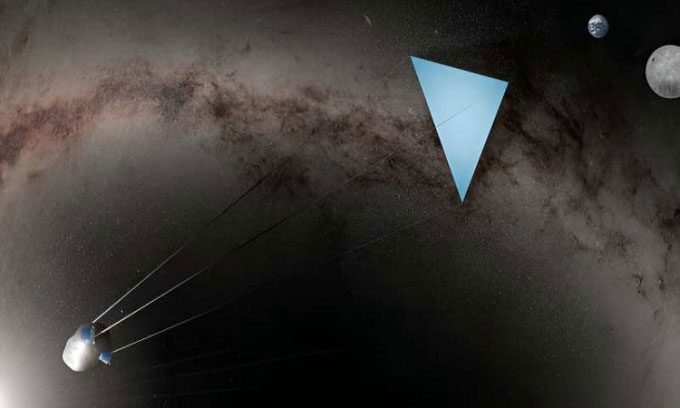An American researcher has proposed using a shield attached to an asteroid to reduce sunlight reaching Earth, thereby preventing an increase in temperature.
The Earth is warming rapidly, and scientists are developing various solutions to mitigate the impacts of climate change. István Szapudi, a researcher at the Institute for Astronomy at the University of Hawaii, has proposed a new solution: a solar shield to reduce sunlight hitting the Earth, tethered to an asteroid as a counterweight. Currently, engineering research using this method could begin to create a feasible design for minimizing climate change within a few decades. Szapudi described the solution in a paper published in the Proceedings of the National Academy of Sciences, as reported by Phys.org on July 31.

Design of a shield attached to an asteroid to cool the Earth. (Photo: Brooks Bays).
One of the simplest solutions to reduce global temperatures is to shield the Earth from some of the sunlight. The idea of a solar shield has been proposed before, but it requires a significant weight to make the shield substantial enough to counteract gravitational forces and prevent solar radiation pressure from blowing it away.
Szapudi’s solution involves two innovations: a tethered counterweight that reduces the total mass of the shield by more than 100 times and using a “captured” asteroid as a counterweight, thereby avoiding the need to launch large masses from Earth. “In Hawaii, many people use umbrellas to block sunlight while walking during the day. I wonder if we can do something similar for the Earth, thus reducing the impacts of climate change?” Szapudi shared.
Szapudi began with the goal of reducing 1.7% of solar radiation. This is the necessary figure estimated to prevent global temperatures from rising to catastrophic levels. He found that placing a tethered counterweight toward the Sun could help reduce the weight of the shield and counterweight to about 3.5 million tons, over 100 times lighter than previous estimates for a shield without a tether.
Although this figure still exceeds current launch capabilities, the shield would only account for 1% of the total weight (35,000 tons) and that is the only component needed to be launched from Earth. With new, lighter materials, the mass of the shield could decrease even further. 99% of the remaining total mass would be the asteroid or lunar dust used as a counterweight. Such a tethered structure would be quicker and cheaper to construct and deploy than many other shield designs.
The largest rockets currently can only carry 50 tons into low Earth orbit, making this method of solar radiation management still a challenge. However, Szapudi’s initiative is more feasible than previous ideas.


















































